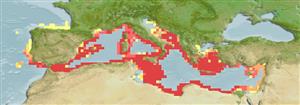Cephalopoda |
Octopoda |
Octopodidae
Environment: milieu / climate zone / تغييرات عمق / distribution range
بوم شناسي
; تغييرات عمق 70 - 700 m (مرجع 96968), usually 250 - 500 m. Subtropical; 45°N - 27°N, 14°W - 37°E
Mediterranean Sea and Northeast Atlantic: from Spain south to Morocco, and the Mediterranean.
Length at first maturity / Size / Weight / سن
بلوغ: Lm ? range ? - ? cm Max length : 16.5 cm ML جنس نر / بدون خواص جنسي; (مرجع 96968); بيشينه وزن گزارش شده: 750.00 g (مرجع 96968)
Minimum depth from Ref. 105634. Benthic (Ref. 1970). Inhabits the lower continental shelf and upper slope. Feeds on crustaceans (Reptantia and Natantia), fish and cephalopods (Ref. 106837).
Life cycle and mating behavior
بلوغ | تولید مثل | تخم ریزی | Eggs | Fecundity | Larvae
Members of the class Cephalopoda are gonochoric. Male and female adults usually die shortly after spawning and brooding, respectively. Mating behavior: Males perform various displays to attract potential females for copulation. During copulation, male grasp the female and inserts the hectocotylus into the female's mantle cavity where fertilization usually occurs. Life cycle: Embryos hatch into planktonic stage and live for some time before they grow larger and take up a benthic existence as adults.
مآخذ اصلی
مراجع | هماهنگ كننده | همكاران
Quetglas, A, M. Gonzales, A. Carbonell and P. Sánchez 2001 Biology of the deep-sea octopus Bathypolypus sponsalis (Cephalopoda: Octopodidae) from the wetern Mediterranean Sea. Mar. Biol. 138:785-792. (مرجع 1958)
وضعيت در فهرست قرمز IUCN
(مرجع 130435: Version 2025-1)
وضعيت از نظر سايتس (مرجع 108899)
Not Evaluated
Not Evaluated
خطر برای انسان ها
استفاده انسانی
ماهي گيري – شيلات: تجاري
| FishSource |
ابزارها
اطلاعات بيشتر
Life cycleتولید مثلبلوغFecundityتخم ریزیEggsنمو تخمLarvae PhysiologyOxygen consumption
Human RelatedStamps, coins, misc.
منابع اينترنتي
Estimates based on models
Preferred temperature
(Ref.
115969): 13.2 - 15, mean 14.2 (based on 117 cells).
Fishing Vulnerability
Low vulnerability (10 of 100).
